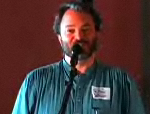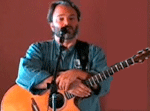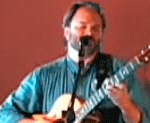Vocal and Guitar Performance Techniques
|
Presentation by Tom Munch This is a video recorded at the 2007 Fall Rocky Mountain Conference held in Cuchara Colorado in 2007. Videos
Then join the ongoing discussion in the Bose Musicians Community Message Boards. |
Vocal Tone
Good air
Diction
Consonants, Ending consonants
Plosives
- Having trouble with popping consonants? Move closer to the microphone. Eliminate plosives by keeping your lips on the windscreen
Chest, throat, nose
EQing with technique
Shape mouth, throat
Push forward or back
Working the Mic
- Moving back from the microphone robs you of tone.
- The ToneMatch® Filters were created for close microphone technique.
Stay Glued to the Windscreen
- If you move your head around the microphone, swivel so that you mouth is always pointed at the windscreen.
Mic is an instrument
Listen & experiment
Guitar Tone
Flesh/nail/pick
EQ with fingers
Flesh & nail
Picks
Hand position
Find good instrument tones for your instrument
Cover all frequencies
Tailor to function in mix
Listen & experiment
Performing
Dynamics
- Good use of dynamics in any performance is a "value add" for your audience. Learning how to perform with dynamics will increase your enjoyment of playing/singing.
Stay out of own way
- Be aware of the relative roles and volumes of your Vocals and your Guitar. Don't compete with yourself by overplaying Guitar while singing.
Match EQ to mix
Don't push/press harmonica player
- Harmonica player = Larry Adler
- Larry Adler interview Tom mentioned with the follow up discussion on the Message Board
turn up if necessary & pull back
Avoid tension
Listen & experiment
Conclusion
Good tone a function of listening & experimenting
Technical Notes
Tom used the following gear in the videos
- L1 Model II and T1 ToneMatch Audio Engine.
- AKG C535 vocal microphone.
- Lowden L32CP with EMG film UST (like Fishman Matrix) & Joe Mills mic mounted just inside the sound hole perpendicular to soundboard.
- Fishman Pocket Blender for Mills mic & EMG on Lowden
- Simon & Patrick with LR Baggs Duet System (older with LB6 saddle)


